Are you a Quiet Speculation member?
If not, now is a perfect time to join up! Our powerful tools, breaking-news analysis, and exclusive Discord channel will make sure you stay up to date and ahead of the curve.
Can you believe it was only a month ago when we were picking through the scattered debris of our once beloved format? Or declaring one deck the first true Tier 0 overlord in Modern history? Following the April 4 banlist update, and the subsequent Modern events from April 8 until today, the horrors of Eldrazi Winter seem like a distant, surreal memory. Hopefully, it's how we'll feel when an American presidential victor is announced on November 9 and a certain Eldrazi-like candidate joins Eye of Ugin as a bygone nightmare. No matter how that battle resolves, the fight for Modern appears over--the R&D Gatewatch have won. As I wrote about last Monday, the banlist changes promise an unprecedented era of format diversity. If last weekend's events are any indication, we're on our way to living that dream.
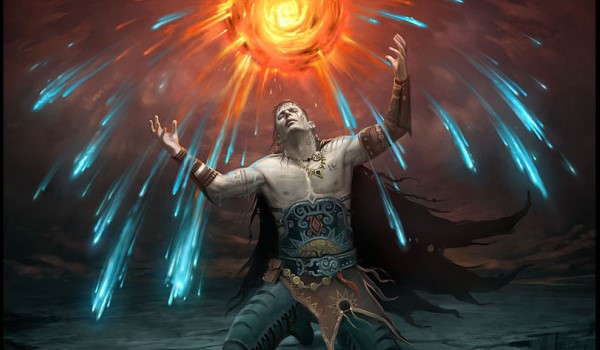
We don't have sufficient data to conduct a full metagame breakdown, but we have more than enough to make some informed projections about where the format might be heading. After Splinter Twin's ban earlier this year, we made a similar analysis of the dramatically altered format landscape, using a sampling of events to get a better sense of metagame direction after a major change. That's also our job today as we parse a selection of tournaments in a world without Eye of Ugin and with both Ancestral Vision and Sword of the Meek. This might be my first week as a Nexus author and not its Editor in Chief, but this ain't my first metagame rodeo and I fully intend to keep the evidence-driven updates coming for as long as I'm around. Strap in for the new Modern and get ready for some data tables!
[wp_ad_camp_1]
Data Collection Methods
Monthly metagame breakdowns, like the Tier 0 tragedy in our last check-in, typically require around 100 paper tournaments and 50-60 events on Magic: The Gathering Online. We're not even close to such an n this time around, but we have the data to sculpt a preliminary metagame snapshot. You can't use this preliminary portrait to determine if Affinity is x% of the metagame with Jund at y%, but you can use it to get a data-driven sense of how the new Modern is taking form.
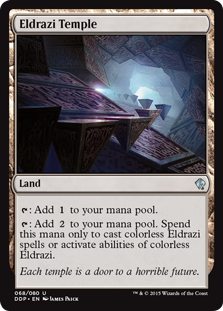 The April 4 ban update went into effect for paper tournaments last Friday, April 8. MTGO will follow later today (Wednesday, April 13). This means today's preview will have paper finishers from the weekend but no online lists, a hole we'll want to fill in later updates. For now, we'll be working with a dataset of 24 tournaments, spanning 146 actual decklists. In almost all cases, these are aggregated Top 8 standings, following the methodology outlined on our Top Decks page, but we add Top 16s and Top 32s for the few tournaments that list them, just to shore up a smaller n. Spoilers: Eldrazi isn't even Tier 2 and Eldrazi Temple hasn't taken over (yet...).
The April 4 ban update went into effect for paper tournaments last Friday, April 8. MTGO will follow later today (Wednesday, April 13). This means today's preview will have paper finishers from the weekend but no online lists, a hole we'll want to fill in later updates. For now, we'll be working with a dataset of 24 tournaments, spanning 146 actual decklists. In almost all cases, these are aggregated Top 8 standings, following the methodology outlined on our Top Decks page, but we add Top 16s and Top 32s for the few tournaments that list them, just to shore up a smaller n. Spoilers: Eldrazi isn't even Tier 2 and Eldrazi Temple hasn't taken over (yet...).
Two disclaimers before we get started. First, early metagame rundowns like these are inherently limited. I've said this at least twice already, and I'm repeating it here for readers who are eager to fire off an "n is too small" rebuttal. We will be mitigating the effects of a small n by acknowledging the continued potential for a changing Modern landscape, focusing on format themes, and emphasizing relative, not discrete, deck shares. Second, I acknowledge the difficulties in extrapolating format-wide trends from smaller, regional events like those in our dataset. Modern's most defining events are historically Star City Games Opens, Grand Prix, and Pro Tours. Our largest event is under 200 players, so we're not seeing those kinds of format-shaping moments yet. We shouldn't worry about this. For one, most Moderners play at this local level, where this kind of analysis of smaller tournaments is highly relevant. Two, these events are the lead-up to all the major paper scenes--we'd be smart to get a jump on the tech and trends before it takes off. Besides, if nothing else, I've already seen literally hundreds of Modern players formulate sweeping format assessments based on the results of Star City Games' Baltimore Classic alone, so buffing that sample size of n = 1 over a thousandfold can only help.
Preliminary Tier 1
In my "Early Metagame Snapshot in Twinless Modern" piece, I avoided deck tiering to reflect an uncertain metagame. After all, it's hard to definitively label a deck as tier-anything when you're building from a dataset with less than 25 tournaments. The problem with this approach is you get a table, like that shown in the "Twinless Modern" article, with too many rows to be too helpful. And that's before you add the potential Tier 3 contenders! I'd rather accept some potential for misclassification and drill a little deeper than leave readers afloat in a sea of percentages, so I'm deviating from the no-tier preview model and constructing some highly preliminary tiers for the new Modern.
Based on our early data collection, here are the initial frontrunners for Tier 1 status. As defined on our Top Decks page, Tier 1 represents the most-played strategies in the format. You must expect to play against any or all of these powerhouses in most Modern events. You should also select your sideboard, and even deck, based on the Tier 1 challengers.
Early Tier 1: 4/8/16 - 4/11/16
Gatewatch, be praised! With no Eldrazi in sight and plenty of archetype and deck diversity, this Tier 1 listing represents a promising start to the new Modern. It also represents a return to normalcy, with BGx leading the pack, the big three linear decks of Affinity, Burn, and Infect vying for top slots, and a Snapcaster Mage deck doing its part for blue. All of that is Modern as we know it, which is a safe and stable way to kick off this next chapter. We even see Tier 1-transient Merfolk reappear in the standings!
Looking over Tier 1, and thinking ahead to some related observations in Tier 2 and Tier 3, here are some of the most important themes to derive from this preliminary top-tier group.
- Jund reigns: Lightning Bolt is still supreme
The BGx mainstay is up almost 9% from the last update, suggesting good news for Jund and Modern alike. First: players appear comfortable in wielding a fair deck in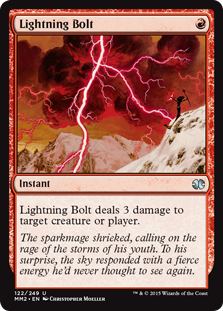 an unknown metagame, not just a goldfish strategy. This didn't happen after Twin's ban, where Affinity, Burn, and RG Tron all trumped Jund in the Tier 1 standings. Jund's initial share might reflect player confidence in the format staying hospitable to police decks, which bodes well for Modern's overall health. Nowhere was this more apparent than the Dutch Open Series Sunday event, a 188-player extravaganza surpassing even Baltimore's attendance which saw four Jund decks in the Top 16 and 9.6% of total players on the midrange monster. Similarly, the Level Up Magic Cup saw three Jund in the Top 8. Second, Jund's top honors underscore Lightning Bolt's continued power, which should come as no surprise after you see Affinity's, Burn's, Infect's, and Merfolk's popularity. Of course, Jund's success is also an endorsement of other staples--Dark Confidant, Terminate, and Kolaghan's Command all combined to earn the deck its 11% share. Meanwhile, Abzan didn't even make the Tier 3 cut, further pointing to red's importance in the BGx policing shell. If you venture into a Modern event, be prepared for Jund's efficient one-for-one removal and beefy clocks.
an unknown metagame, not just a goldfish strategy. This didn't happen after Twin's ban, where Affinity, Burn, and RG Tron all trumped Jund in the Tier 1 standings. Jund's initial share might reflect player confidence in the format staying hospitable to police decks, which bodes well for Modern's overall health. Nowhere was this more apparent than the Dutch Open Series Sunday event, a 188-player extravaganza surpassing even Baltimore's attendance which saw four Jund decks in the Top 16 and 9.6% of total players on the midrange monster. Similarly, the Level Up Magic Cup saw three Jund in the Top 8. Second, Jund's top honors underscore Lightning Bolt's continued power, which should come as no surprise after you see Affinity's, Burn's, Infect's, and Merfolk's popularity. Of course, Jund's success is also an endorsement of other staples--Dark Confidant, Terminate, and Kolaghan's Command all combined to earn the deck its 11% share. Meanwhile, Abzan didn't even make the Tier 3 cut, further pointing to red's importance in the BGx policing shell. If you venture into a Modern event, be prepared for Jund's efficient one-for-one removal and beefy clocks.
- Ancestral Vision leads a Grixis comeback
We haven't seen a single Snapcaster Mage deck in Tier 1 since Twin's imprisonment. We also haven't seen a Grixis Snapcaster deck in Tier 1 since Grixis Twin in October, and a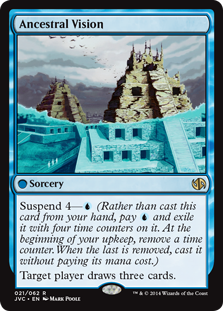 Twinless Grixis Snapcaster deck since August. Trevor is going to be happier than Brian Kibler following Wild Nacatl's parole. Outside of leaning more midrange than control, Grixis hasn't changed at all since January... That is, except for Ancestral Vision. Vision's addition has catapulted Grixis Midrange from Tier 3 doldrums to Tier 1 prominence. Only 18% of weekend Grixis lists didn't run Vision, with the other 82% averaging 3.6 copies in the maindeck. These results suggest the theories surrounding Vision's power were accurate--the card is Tier 1 material but doesn't appear to be format-breaking. Grixis was the only Vision deck to push into Tier 1 (Jeskai snagged Tier 2), and it didn't even dethrone top dog Jund. Perhaps this will change in coming months, but if trends hold, Vision looks to be exactly the post-Twin jolt blue mages needed. Prepare accordingly for the one-two-three punch of early Inquisitions, Mana Leaks, and Spell Snares leading into meaty Tasigurs and Anglers, all with Vision to refuel on turn five or later.
Twinless Grixis Snapcaster deck since August. Trevor is going to be happier than Brian Kibler following Wild Nacatl's parole. Outside of leaning more midrange than control, Grixis hasn't changed at all since January... That is, except for Ancestral Vision. Vision's addition has catapulted Grixis Midrange from Tier 3 doldrums to Tier 1 prominence. Only 18% of weekend Grixis lists didn't run Vision, with the other 82% averaging 3.6 copies in the maindeck. These results suggest the theories surrounding Vision's power were accurate--the card is Tier 1 material but doesn't appear to be format-breaking. Grixis was the only Vision deck to push into Tier 1 (Jeskai snagged Tier 2), and it didn't even dethrone top dog Jund. Perhaps this will change in coming months, but if trends hold, Vision looks to be exactly the post-Twin jolt blue mages needed. Prepare accordingly for the one-two-three punch of early Inquisitions, Mana Leaks, and Spell Snares leading into meaty Tasigurs and Anglers, all with Vision to refuel on turn five or later.
- The Big Aggro Three are here to stay
Grixis hasn't quite earned "format pillar" status, but Burn, Infect, and Affinity certainly have. No one who tracks Modern data should be surprised by their persistence; linear decks are historically reliable options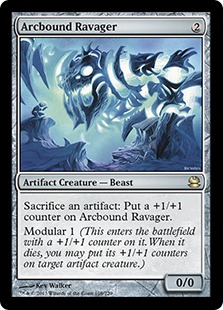 for uncertain fields, and last weekend was no exception. What is far more surprising is their order. Burn doubled Affinity's share, with Infect (often the least-played of the three) beating the robots too. As if to rub it in, Merfolk even equaled Affinity in these early standings, a tie that has never happened in our metagame tallies to date. Part of this is undoubtedly Tier 1's increased artifact hate (Ancient Grudge, Shatterstorm, Vandalblast, etc.). With Sword of the Meek and Thopter Foundry on everyone's minds, artifact hate will be rampant and Affinity has likely suffered. Pilots may also have expected such hatred and steered clear. It's also possible this is a small n anomaly and will reverse as we get more events, but that isn't supported by data from the Dutch Open Series where 13 players brought Affinity to Round 1 and zero made Top 16. This may highlight a fundamental Affinity weakness in the new Modern. Going ahead, I'd still expect all three equally. Make sure you have gameplans for these blistering competitors!
for uncertain fields, and last weekend was no exception. What is far more surprising is their order. Burn doubled Affinity's share, with Infect (often the least-played of the three) beating the robots too. As if to rub it in, Merfolk even equaled Affinity in these early standings, a tie that has never happened in our metagame tallies to date. Part of this is undoubtedly Tier 1's increased artifact hate (Ancient Grudge, Shatterstorm, Vandalblast, etc.). With Sword of the Meek and Thopter Foundry on everyone's minds, artifact hate will be rampant and Affinity has likely suffered. Pilots may also have expected such hatred and steered clear. It's also possible this is a small n anomaly and will reverse as we get more events, but that isn't supported by data from the Dutch Open Series where 13 players brought Affinity to Round 1 and zero made Top 16. This may highlight a fundamental Affinity weakness in the new Modern. Going ahead, I'd still expect all three equally. Make sure you have gameplans for these blistering competitors!
- Oh Sword of the Meek, where art thou?
Vision did its part to elevate Grixis Midrange into Tier 1, but the Thopter/Sword combo is still waiting for its big break. Sure, Darrel Feltner wedged the artifacts into his UW Tron list at the Baltimore Classic, but he didn't have much company. Only about 5% of players this weekend used the combo in any list, and no single strategy was higher than about 2%. As we saw in our Affinity discussion, intensified artifact hate is partly to blame, especially because such silver bullets are so obvious (just run more anti-Affinity cards!). That said, it's unlikely this was the only factor in Sword's early absence. Nor is the combo's power to blame--Lucas Siow won the Mana Deprived Super Series with an Esper Gifts Thopter/Sword variant, suggesting the strategy has real wings. Its current weakness is lack of an obvious home. There are dozens of ways to churn out Thopter tokens, and Moderners are still building and brewing. I don't expect this to change until the June Grand Prix, although the upcoming SCG Columbus Open will help narrow the field. Don't ignore the combo entirely, but don't be too afraid. It's a long way from Tier 1 right now.
have much company. Only about 5% of players this weekend used the combo in any list, and no single strategy was higher than about 2%. As we saw in our Affinity discussion, intensified artifact hate is partly to blame, especially because such silver bullets are so obvious (just run more anti-Affinity cards!). That said, it's unlikely this was the only factor in Sword's early absence. Nor is the combo's power to blame--Lucas Siow won the Mana Deprived Super Series with an Esper Gifts Thopter/Sword variant, suggesting the strategy has real wings. Its current weakness is lack of an obvious home. There are dozens of ways to churn out Thopter tokens, and Moderners are still building and brewing. I don't expect this to change until the June Grand Prix, although the upcoming SCG Columbus Open will help narrow the field. Don't ignore the combo entirely, but don't be too afraid. It's a long way from Tier 1 right now.
I fully expect the next few weeks of data to challenge some of these Tier 1 developments, especially moving past the Columbus Open. That said, my data senses are tingling and this preliminary Tier 1 makes enough metagame and statistical sense that I don't expect it to change dramatically through April and even May. Deck order will change, and I wouldn't be surprised if something like Merfolk dropped out of Tier 1 entirely, but the overall picture today shouldn't be too different from the picture in a month's time.
Preliminary Tier 2
Even with limited data, it's relatively easy to draw conclusions about Tier 1. These format mainstays tend to stick around from metagame cycle to metagame cycle, and if they show up in a new Tier 1 listing, there's a good chance we'll get most (if not all) of them right. Tier 2 is far trickier. At the top of the Tier 2 roster, we'll see decks less than a percentage point under the Tier 1 cutoff. At the bottom, we'll see strategies only a statistical nose ahead of Tier 3. This happens in every metagame breakdown but is most pronounced in snapshots like today's. To account for this, we'll want to keep our Tier 2 expectations flexible, understanding the potential for considerable movement as the format solidifies.
As in previous articles, Tier 2 represents competitive Modern strategies. You do not need to explicitly prepare to face each and every one of these decks, but you should have a general understanding of what all of them are accomplishing. For instance, if you lose to Ad Nauseam at instant speed with your win condition on the stack, you have no one to blame but yourself. Tier 2 strategies also have a baseline of success to suggest they are viable choices for upcoming Modern events, and I encourage you to try any of them at your next tournament.
Early Tier 2: 4/8/16 - 4/11/16
Because our Tier 1 bracket is a bit wider than usual, our Tier 2 listing has necessarily narrowed. We could have instead broadened it on the back-end, but that would have included six Tier 3 decks in the mix, some of which may yet be Tier 2 material (Naya Company, Esper Gifts with Thopter Foundry), and others which might barely have a Tier 3 claim at all (UR Delver, UW Tron). We'll see those potential upstarts later, but for now we're going to focus on core decks I expect will stay Tier 2 even as the metagame develops beyond these preliminary numbers. Here are the core themes from this group.
 Modern appears slower, fairer, and more interactive than in the past
Modern appears slower, fairer, and more interactive than in the past
Despite the presence of the Big Aggro Three and some combo win conditions, Tier 1 and Tier 2 are both pointing towards an overall tamer metagame. None of the current Tier 2 decks, admittedly a small subset at only five strategies total, can realistically win before turn four, with most geared for turn five wins or later. Scapeshift is the epitome of this approach, with pilots opting for a Bring to Light or traditional Temur build instead of the faster Primeval Titan versions (which themselves languish in Tier 3). Are these decks all proactive? With the exception of Jeskai Control, absolutely. But proactive should not be confused with unfair or non-interactive, and overall these changes might signal a shift to a format-wide slowdown which would benefit grindier cards and strategies.
- The new Tier 2 should be similar to the old Tier 2
See any new faces in Tier 2? Although the tier is likely to develop as candidates from Tier 3 earn a promotion, it's unlikely to be much different from the Tier 2s we are accustomed to in previous metagames. Certainly, most of the current Tier 2 decks are Modern regulars, perhaps with the exception of Kiki Chord which has lingered in Tier 3 in some previous updates. Going ahead, I'd expect some of the Tier 3s such as Naya Company, Abzan Company, and Living End to make it back into Tier 2, maybe even joined by newcomers like Esper Gifts (Thopter style). This means your past Modern experiences will serve you well in the new metagame and, excepting those new Thopter/Sword decks, you won't have to relearn too many matchups, playlines, and sideboard strategies.
- RG Tron endures
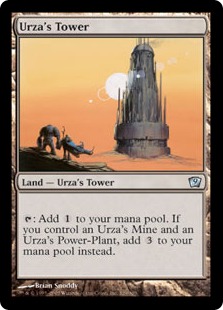 Who needs Eye of Ugin anyway? In fairness, Tron took a dive from Tier 1 glory, where it had occupied slots for months, into Tier 2, but a) that's probably for the best (it keeps the deck viable while promoting other strategies), and b) it speaks to the enduring power of Tron's engine. Even without Eye, the deck is still powerful and will still see play in Modern. If anything, it might become more annoying and problematic for those Jund pilots who think they can ditch their land hate from their sideboards. I'm not a fan of that matchup lottery aspect of Modern, but Tier 2 Tron is a fair addition to Modern and I expect we'll see it there for months to come. Keep land destruction handy and look for effects that span multiple matchups--Fulminator Mage should be an obvious candidate here.
Who needs Eye of Ugin anyway? In fairness, Tron took a dive from Tier 1 glory, where it had occupied slots for months, into Tier 2, but a) that's probably for the best (it keeps the deck viable while promoting other strategies), and b) it speaks to the enduring power of Tron's engine. Even without Eye, the deck is still powerful and will still see play in Modern. If anything, it might become more annoying and problematic for those Jund pilots who think they can ditch their land hate from their sideboards. I'm not a fan of that matchup lottery aspect of Modern, but Tier 2 Tron is a fair addition to Modern and I expect we'll see it there for months to come. Keep land destruction handy and look for effects that span multiple matchups--Fulminator Mage should be an obvious candidate here.
In many respects, Tier 2 is even less defined than Tier 1. Decks might fall out of Tier 1 and land in Tier 2, just as other strategies might climb from their Tier 3 status up into the next echelon. Expect a lot of change here, but regardless of what specific decks stick around, these three themes should still hold.
Preliminary Tier 3
We end our metagame preview with a peek at Modern's Tier 3. Strategies in Tier 3 may be competitive, but their viability is heavily dependent on tournament and metagame context. Player familiarity is also critical when piloting a Tier 3 deck, because many lack the proven power to cut it on their own. Before sleeving up one of the Tier 3 journeymen for your next event, make sure that choice makes sense relative to your expectations of the local metagame. Living End might be a great Tier 3 option if your area is heavy on Jund, but if you know Infect is huge at your local shop, then steer clear.
Early Tier 3: 4/8/16 - 4/11/16
As usual, Tier 3 is a mess. It's hard to identify core Tier 3 themes even in larger datasets, and downright vexing when your metagame only encompasses 24 events. That said, there are two overarching narratives we can pull away from this table. Maybe three if we count "PLAY ALLIES AND GO FOR BROKE," but I'm more confident in the other narratives than I am in Kabira Evangel's odds in this new format.
 My biggest Tier 3 takeaway is just how familiar many of its decks look. Abzan Company, Living End, Elves, Naya Company, Bogles: these are all much more regular Tier 2 participants, not Tier 3 stragglers. That's par for the course in a smaller-n metagame update, and points to Modern's remaining room for growth and evolution. I expect many of these Tier 2 household names to get back into Tier 2 as more fringe contenders take their place at the bottom. This leads directly to my second Tier 3 takeaway, which is the hidden potential of decks in this classification. The metagame is wide open and any of these strategies, except maybe my darling Evangels, could take off in the coming weeks. Don't shy away from these decks just because they appear Tier 3 for now. Diamonds may yet lie in this rough.
My biggest Tier 3 takeaway is just how familiar many of its decks look. Abzan Company, Living End, Elves, Naya Company, Bogles: these are all much more regular Tier 2 participants, not Tier 3 stragglers. That's par for the course in a smaller-n metagame update, and points to Modern's remaining room for growth and evolution. I expect many of these Tier 2 household names to get back into Tier 2 as more fringe contenders take their place at the bottom. This leads directly to my second Tier 3 takeaway, which is the hidden potential of decks in this classification. The metagame is wide open and any of these strategies, except maybe my darling Evangels, could take off in the coming weeks. Don't shy away from these decks just because they appear Tier 3 for now. Diamonds may yet lie in this rough.
Speaking of potential diamonds in the rough, here's bonus takeaway number four: Eldrazi is smashed to where it belongs, but expect the deck to rise again. Its continued Tier 3 viability, even after a huge ban, suggests we haven't seen the last of the monsters.
One Weekend Down, Columbus to Go!
We're 24 events into the season and SCG's Columbus Open this coming weekend is going to be a big #25 in our dataset. Add all the other smaller tournaments along the way, and you can bet we'll be back next week with another metagame check-in for our new Modern. No matter how Columbus turns out, barring some unholy Eldrazi Temple-fueled coup, Modern is unlikely to look much less promising than we've seen today. Personally, I haven't been this optimistic about Modern's future since just before the Twin ban, and if this was Wizards' vision of the post-Twin format, sign me up for more.
Thanks for reading and let me know in the comments if you have any questions about the tournaments, the format, the numbers, or the different decks we've talked about today. Keep on crunching those numbers as you select your deck for Columbus and I'll talk you all soon!





Interesting to see Jund at the top of the heap after all of the doomsaying regarding the rise of the Thopter overlords (Reid Duke, of all people, was saying he wouldn’t play Jund in Modern. Reid Duke!). BGx Midrange truly is the format’s Terminator.
On the other hand, I am surprised to see a deck like Abzan Company languishing in Tier 3 (when it was widely predicted to be Tier 1 in the coming meta), while Kiki Chord is living it up in Tier 2. I get that the meta is currently geared pretty strongly toward aggro, but Kiki’s slower combo kill arguably makes it softer toward that sort of deck than Abzan Company, doubly so if the attackers are evasive. I know, I know, small sample size, but it’s still odd.
Lastly… do we have any data on what the Eldrazi decks that did show up look like? I’m guessing they will be Colorless Stompy decks in line with what Jordan presented on Friday, but I’d like to be sure.
Hard to kill the “best 3 colors of modern goodstuff” deck.
That’s pretty much it’s greatest strength.
Now we just need a few good counterspells and make BUG/Sultai midrange a T1 deck and I’ll be happy man
Company decks will likely bounce back. Since the article itself pointed out the sample is quite small (not to mention the time since the banlist shift), I’m inclined to say It was just a meta call for these first few events.
Jund’s presence at the top is surprising to many, but I’m not sure why. Although AV is an uphill battle for the Jund mage, it’s a much better answer-deck for the aggressive strategies which struggle against Bolt. Moreover, with RG Tron out of the picture in any serious way, the deck looks much better than it was even before Eldrazi. I expect it to stay around Tier 1 for a while.
That said, the Company decks in Tier 3 (and Tier 3 generally) should move around a lot as the format keeps growing. I expect plenty of those decks to make it into Tier 2 within a month.
As for Eldrazi, it’s only been GW and BW so far, although I’m sure that will change as we get more events added.
Your profile info still says “Editor in Chief” :).
Nitpicks aside, this was a wonderful article to read. Truly a job well done.
Fixed! Thanks for that catch; would probably have missed it for a while. Glad you enjoyed the metagame update! Stay tuned for more next week.
It almost looks like the new standard in that people generally went aggro at first. Once the top aggro and to some extent combo decks are established, control and metagame decks will emerge.
I wouldn’t say they want aggro at first. The huge uptick in Grixis Midrange (from Tier 3 obscurity to Tier 1) and Jund’s early head start are great indicators of a healthy format. That said, I expect to get at least one more fair deck in Tier 1, whether another blue-based deck or a Company deck. Aggro should stick around, but the format should feel much slower than it has in the past. Win-win for Modern!
Rude of you to call Bernie Sanders “Eldrazi-like,” even if he is as old as Kozilek.
He’s older than an Eldrazi hedron, but not quite as ceaselessly hungry as another candidate.
I’m not sure if there’s enough of a sample size here to draw conclusions. The difference between Tiers 2 and 3 appears to be whether a deck appears 3 or 4 times, and the difference between Tier 1 and 2 appears 5 or 6 times. The only confident conclusions that I can draw from this regards the top 4 decks being sold Tier 1 bets.
It would have been hard for me to give any more disclaimers about the limits of this sample, which are everywhere in the article. There’s literally a paragraph about it, on top of numerous other smaller mentions. Based on what data we do have, we can draw some limited conclusions on format themes (that get more limited as we move down from Tier 1 to Tier 2), and that’s exactly what happened here. Plenty of players and authors have drawn conclusions on a single event in SCG Baltimore, and we are going to do the same thing here with an additional 23 tournaments and over 100 new decks.